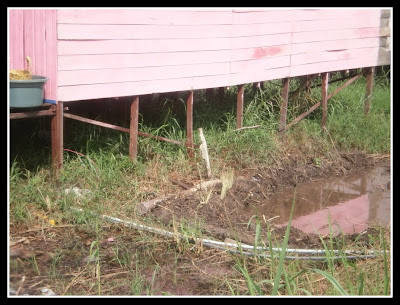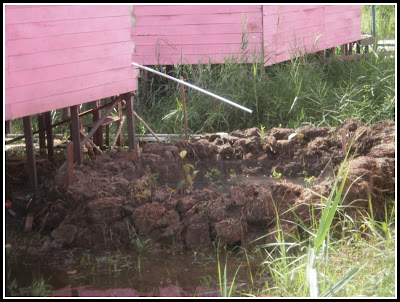In the beginning of the 19th century the inaccessible inlands of Borneo was entirely unknown to the Western people. The untouched, unknown terrain and the dangerous Dayak made explorations very difficult.
In 1825, George Müller, major of the Koningklijk Nederlandsch Indisch Leger (KNIL , Royal Dutch Indian Army), lead the first expedition to the catchment area of the Kapuas river. He followed the river upstream and travelled over the mountains to the Kapuas river. There, his crew was ambushed by Dayak, on the order of the sultan of Kutai; not a single person survived. Müller was decapitated with a mandai. Decades later a mountain range in Central Borneo was named after him.
Three years after the violent death of Müller the Engish merchand Dalton spent fifteen exciting months in Kutai. He made the first reports on paper about the inland Dayak. A series of articles in The Singapore Cronicle gave an interesting view on their live, however incomplete.
First explorations
Only in 1843 the governor-general in Batavia permitted, with dislike, a more torough exploraion of Borneo. This meant that the regional rulers were allowed to support the expedition with several soldiers in local events. The Dutch did only have low manpower and not too much money, and the priority of the government were still Jawa and Sumatera. The condition of 1843 offered views to missionaries and researchers, in an effort to see something back of his expenditures, the governor ordered the land already opened area had to be checked for mineral resources.
The first big expedition was lead by the German geologist Von Gaffron. In 1846 he started his trail from Kota Waringin along the southern coast to Pontianak in the west. In 1848 Dutch Borneo consisted of two residences: the ' Wester-afdeeling (western department) with capital Pontianak, and the 'Zuider- en Ooster-afdeeling' (Southern and Eastern department) with Banjarmasin as capital. Another geologist, C.A.L.M Schwaner, used the disclosure of the inlands from Sintang; he trailed along the Kapuas further inland, to go south and cross the mountain range eventually, which is now named after him.
Carl Bock, a Danish nature lover, crossed a part of the island in 1879. He persuaded the sultan of Kutai to join him, followed the Mahakam upstream, crossed the mountains to the catchment area of the Barito river and reached the coast near Banjarmasin. Following his noted Kutai was the biggest and most powerfull sultanate of Borneo at that time. Almost one fifth of the island was under his influence.
The sultan earned money on it's salt monopoly and from taxes on regional trade. In the 1880's, the saltprice along the upstream of the Mahakam river was 15 times higher than in Samarinda. Because of this, many Dayak made the heavy journey to Sarawak to get some of the precious product against a reasonable price. However the sultan lived in Tenggarong at the end of the 19th century, Samarinda was more powerfull with it's 10,000 residents.
In the 1890's, the geologist G.A.F Molengraaff explorated the catchment area of the Kapuas river intensively, before he crossed the mountains and followed another river towards the south.
The headhunters meeting
In 1894, a very unusual, three month lasting peace meeting was held in Tumbang Anoi, along the upstream of the Kahayan in Central Kalimantan. On this top-conference, over thirty Dayak leaders agreed to stop hostilities and headhunting. The agreement was the first sign of unity among the Dayak. This was the result of a proces which lasted for centuries, in which the Dayak first entered the inlands, fought against eachother and eventually came into a big conflict with the Western colonial powers. The agreement cleared the road for expeditioner A.W. Nieuwenhuis. He became the first European which crossed Borneo from west to east, from Pontianak to Samadinda, with as climax the crossing from the Kapuas to the Mahakam river. A hundred men participated in this fifteen-month-journey. The heart of Borneo was opened.
The Dayak around the upperstream of the Mahakam asked the Dutch for protection. With terror they reminded the attack of the Batang Lupar Iban from Sarawak in 1885. Above all their relation with the sultan of the downstream Kutai was not good at all. Nieuwenhuis reported thievery, enprisonment, exploitation and strict conversion.
The Dutch rule had importance by a stop of the spread of islam, and Nieuwenhuis ensured the Dayak, which loved pork and rice-wine, that there was not reason for them to become muslem. The settlement of a Dutch military outpost in Long Iram was a proof of that. In 1908 the sultan of Kutai gave away his rights on the upperstream of the Mahakam river, in trade for a yearly payment by the Netherlands.
Missions
Until halfway the 19th century, the European contacts were limited mainly to the coastal areas. The population was almost entirely islamic and was against christianity. For missions there was nothing else byt to aim at the inlands. When there was an opportunity, the German misscion was there; it first travelled through Southern Kalimantan, and from there is went to the southern part of Central Kalimantan.
The Banjarmasin War in 1859, in which several missionaries and their families were killed, the demand for missions deminished. Elsewhere their colleagues didn't stop. Eventually there were missionaries along the Kapuas and Mahakam, near governmental buildings and far away from islamic influences.
In contrary to Sarawak, where the 'White Raja' Brooke respected the animist way of life of the Dayak, and stopped the missionaries which were bound for the inland, christianity was encouraged in Dutch Borneo. The Dutch tried to end the headhunting by punish those who still continues with forced labor. Among the veteran fighters, results were not booked. The Dutch did everything to stop this 'outlaw ritual' of the Dayak, for example by destroying the trophy's they found. Still, the headhunt-journeys were held until the 1930's.
|








.jpg)
















